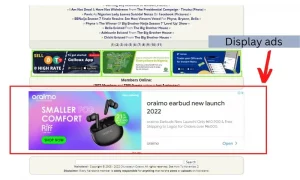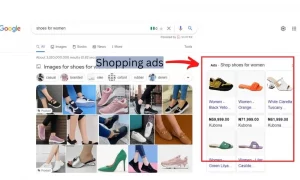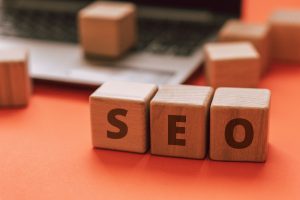In this post, you will get an overview of pay-per-click advertising which is arguably the fastest way to create awareness for your products and services, attract new website visitors, and drive conversions for your business.
If you have ever noticed the advertisements that appear alongside search results on Google and other search engines, you are already familiar with pay-per-click, or PPC advertising.
Table of Contents
ToggleWhat is PPC (pay-per-click) advertising?
It’s a form of advertising where if you’re an advertiser you pay for each click on your online ad – The clicks could lead to website visits, it could be an app installation or a phone call.
There are a lot of things you could advertise using pay-per-click (PPC) advertising.
And as the term describes – pay per click, you’re paying for every single click you are driving.
You don’t pay for impressions.
You’re paying for clicks specifically.
Google has a PPC advertising platform. And it’s search ads are the most popular type of pay-per-click ads used by advertisers and marketers.
For example, in the search query “best hotels in Lagos” the following results are served on the SERP or search engine results page. The first and second search listings highlighted in the image below are search ads.
(All images are for illustrative purposes only)
Search Ads

Asides from its search ads, Google also runs other types of ads on its advertising network including:
Display Ads
As the name implies, display ads are visual ad formats that are served to online users on web pages or apps. These are often made up of text-based, image, or video advertisements that encourage users to click through to a landing page or app store and take action (e.g make a purchase, or download an app).
For example, a banner ad by Oraimo served on a third-party webpage

Shopping ads
For the search query “Shoes for women” the following results are served on the SERP or search engine results page.
The catalog on the right-hand side of the SERP is an example of a shopping ad.

These ads appear when internet users search for things online using a search engine like Google.
However, user search intent differs and PPC ads tend to appear when users are performing commercial searches, meaning they are looking for something to buy.
Facebook can also be considered a pay-per-click advertising network even though technically it’s not.
It’s social advertising and you’re generally paying for impressions on Facebook ads.
Generally, how pay-per-click work is you are going to set a bid for clicks to your website.
You are either bidding on keywords or audiences.
And you are setting a bid for how much you’re willing to pay for each click to your website.
How does PPC work?
You can start by using popular pay-per-click advertising networks such as
1. Google ads
2. Bing ads
3. Facebook ads
You need a website or an app to promote.
And then once you have your website and you’re ready to promote you want to create different landing pages.
Landing pages are where you’re going to be sending traffic with the aim of driving some kind of conversion.
And then once you are ready to start creating ads, sign up with the pay-per-click network of your choice.
Enter your payment information, and start creating your first campaign.
The key is testing and optimizing your campaigns.
As you might know, It’s becoming more challenging to get traffic to your website just through organic search alone.

That’s why a lot of companies are running pay-per-click ads.
It’s worth it for businesses of all sizes.
If you are considering doing paid advertising, you might be wondering
What is the cost per click for a PPC ad?
Well, the answer is it depends.
It all depends on how much competition there is for the space where you want to put your ad.
To put things into perspective, the average cost per click across industries is between $1 and $2.
Some are as cheap as a few pennies, while others can cost more than $50 per click.
Another key term you should know is CPM.
CPM stands for cost per thousand impressions and applies to display ads only.
As opposed to the cost per click where you pay based on how many times your ad is clicked.
CPM is based on impressions alone.
You’re buying the right to simply show your ad 1000 times regardless of how many times it’s clicked.
Is PPC Relevant To Your Business?
As mentioned earlier, PPC advertising is worth it for businesses of all sizes and this is because Pay per Click advertising is extremely targeted.
You can choose precisely who to show your ads to based on location, keywords, interest, age, gender, language, and even the type of device.
So you are advertising your goods and services directly to the people who are most likely to be interested in what you have to offer.
Not only that, you can even adjust your ads for people who have already visited your website.
This type of PPC advertising is called Retargeting.
On average, out of every hundred people that visit your website, only two will convert into actual customers.
That means 98% of initial traffic virtually goes to waste.
Retargeting lets you place ads that remind the people who left your website or landing page without converting to come back and check out the products and services they missed.
This in turn helps you capture more of the 98% of people who didn’t convert the first time.
PPC Advertising is Cost-Effective
After all, the only time you pay a fee is when your ad is clicked.
When you consider the fact that the top three advertising spots on a search results page get 46% of the clicks, the odds are really in your favor.
You’re up there at the top of the list even above the top organic results.
PPC Advertising is Trackable
This means you can monitor your ads’ performance and adjust them accordingly.
If one ad isn’t giving you as many clicks as you’d like.
You always know exactly which ads are driving sales and helping your business and which ones aren’t.
Flexibility comes hand in hand with PPC.
Lastly,
PPC Advertising is Fast
While ranking high in organic search results is important, it takes time to get there.
But with pay-per-click, you can put a new ad up and start seeing results in a matter of days, if not hours.
So if you’re looking to immediately attract more traffic to your website and boost sales, you may want to give pay-per-click some serious thought.
3 Steps to achieving a successful PPC campaign
A lot goes into building a winning PPC campaign: researching and selecting the right keywords, organizing those keywords into well-organized campaigns and ad groups, and setting up PPC landing pages optimized for conversions.
However, from a bird’s eye view, a winning PPC advertising campaign can be broken down into three (3) primary steps, which are:
- Tracking
- Testing
- Optimizing
A lot is going on in between all of that, but when you look at it from a broad perspective, those are the three essential steps you must follow to create successful pay-per-click advertising campaigns.
Tracking
Every pay-per-click advertising network that you can work with has its conversion tracking guides.
Google ads conversion tracking can be set up with Google Tag Manager and Google Analytics.
You can add any conversion tracking setup (Google ads with Tag Manager/Analytics) to your website to track conversions more easily for Google ads.
Why set up conversion tracking for PPC campaigns?
You would want to set up conversion tracking because you will see how your ads are performing for any selected PPC advertising platform within that platform.
And then you can also optimize your campaigns automatically for your conversions.
So whether you’re trying to drive sales on an e-commerce website, or drive leads for your website, regardless of what your desired conversion action is, you can create a conversion tracking tag through your selected PPC advertising platform, track these conversion actions and optimize your campaigns for them.
Now you might be wondering
How does conversion tracking work?
Regardless of the pay-per-click advertising channel that you’re using, you want to make sure that you’re tracking conversions.
When you’re setting up campaigns, the first step you want to take is to make sure that you’re connecting your website with the pay-per-click advertising channel so that you can track everything that’s happening on your website.
And you can see when you’re driving sales (or whatever conversion you want to track) and tie it back to a specific advertisement, to the specific targeting, and see the landing page that people visited before they completed one of your conversions.
Testing Your Targeting, Ads & Landing pages
Once your campaigns are set up and you are monitoring conversions, the next step is testing.
Campaigns generally include a combination of targeting, advertisements, and landing pages.
You want to test all of them.
The best practice to ensure that your campaigns are successful is to constantly test the different elements of your campaign – Targeting, Adverts, and Landing pages.
You may use interest targeting, keyword targeting, retargeting, or content targeting when it comes to your advertising targeting.
For any targeting strategy you choose to use, you will create multiple ads and test your landing pages.
In addition, you want to test different PPC advertising channels and see what works for your business.
Optimizing PPC campaigns
Third and most importantly, you need to optimize your PPC Advertising campaigns.
You cannot set up a campaign and forget about it and expect to get the results you are looking for.
The more you create and optimize new advertisements, the more targeting you test, and the better you create your landing pages, the better your campaign will perform.
Optimization is key to PPC Advertising, especially if you want to have a positive return on ad spend.
Conclusion
The greatest benefit PPC has to offer is that it helps give your website the attention it deserves from the people who will appreciate it most as fast as possible. With pay-per-click ads, you only pay when your ads are clicked.
There are various PPC advertising networks but Google ads are the most popular. Common types of Google ads include search, display, and shopping ads.
Keep in mind, for best results, you need to test and optimize your ads for several months, I’d recommend between 3-6 months, while you are running campaigns on any PPC advertising channel.
So there you have it! – PPC advertising in a nutshell.




